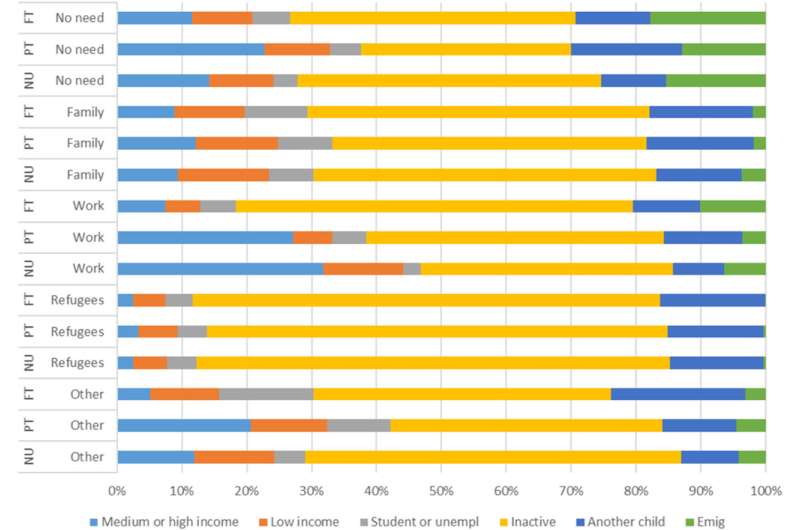This article has been reviewed according to Science X's editorial process and policies. Editors have highlighted the following attributes while ensuring the content's credibility:
fact-checked
trusted source
proofread
Flexible parental leave among immigrant mothers can promote integration

Mothers who took parental leave part-time or for shorter periods were more likely to engage in income-generating activities or pursue education. A new study uncovers surprising patterns in parental leave usage among newly arrived migrant women in Sweden, specifically focusing on their integration into the labor market.
The findings, published in the Journal of European Social Policy, provide new insights into how parental leave is used and how it affects labor market participation among newly arrived mothers who arrived in Sweden with young children.
The analysis reveals a polarization in the use of parental leave, with a significant number of mothers refraining from it while some took quite long leaves. Surprisingly, native-born mothers who returned with their children born abroad showed high usage of parental leave together with some groups of mothers with origin in Syria, Somalia, and Thailand.
However, the authors were surprised that parental leave usage plays a limited role in the future labor-market activity of newly arrived mothers.
"Our study challenges the traditional view of parental leave among immigrant mothers. We found that part-time parental leave, contrary to what one might expect, actually fosters better integration into the labor market and educational pursuits, rather than hindering it," says Eleonora Mussino, a researcher at the Stockholm University Demography Unit at the Department of Sociology, and main author of the study.
The finding underscores the potential of flexible parental leave policies in aiding the integration process. The authors interpret this to mean that short breaks from labor market participation don't necessarily hinder subsequent employment. In fact, part-time parental leave could offer immigrant mothers other ways of integration, such as through essential support and contacts, particularly if they spend this time on training or language acquisition.
"This research not only challenges existing perceptions but also opens new avenues for policy development, ensuring that Sweden's family policies align with the diverse needs of its changing population," says Eleonora Mussino.
The study utilized comprehensive data from the Swedish population and social insurance registers and focused on 82,800 women who immigrated to Sweden between 1995 and 2014 with at least one child under the age of 8.
Sweden, up until 2016, extended a generous parental leave offer to immigrants arriving with preschool-aged children. In 2017, age-based restrictions on parental leave for immigrant children were introduced.
"Unfortunately, our data did not capture the recent restrictions of parental leave days for foreign-born children. However, given the results in our analysis, we can expect minimal, or no, impact on labor-market integration due to this policy change," says Eleonora Mussino.
"The insights from our research are pivotal for shaping future policies. They suggest that a generous parental leave policy does not necessarily delay labor market integration for immigrant mothers. Instead, it can provide a support system during their initial transition period in a new country," adds Ann-Zofie Duvander, Professor of Demography at the Department of Sociology and co-author of the study.
How the study was done
- The study utilized comprehensive data from the Swedish population and social insurance registers and focused on 82,800 women who immigrated to Sweden between 1995 and 2014 with at least one child under the age of 8.
- The studied population includes Swedish-born woman as well migrant-born. Country of birth is categorized by the ten largest groups in the population (including native-born return immigrants), with all others aggregated in the category 'miscellaneous.'
- The researchers followed the women for two years after their year of arrival to analyze whether their use of parental leave correlates with subsequent labor-market attachment.
- Labor-market attachment is measured based on the main economic activity (wages and entrepreneurial activities) and public transfers received in a certain year (unemployment benefit and student loan). The variable is categorized into 1) student or unemployed, 2) work with low income, 3) work with medium/high income, and 4) inactive, with no income from work or work-related benefits such as unemployment or student benefits, and women who 5) have another child, or 6) emigrate.
More information: Eleonora Mussino et al, Parental leave use among newly arrived immigrant mothers in Sweden: Causes and consequences, Journal of European Social Policy (2023). DOI: 10.1177/09589287231216688
Provided by Stockholm University




















